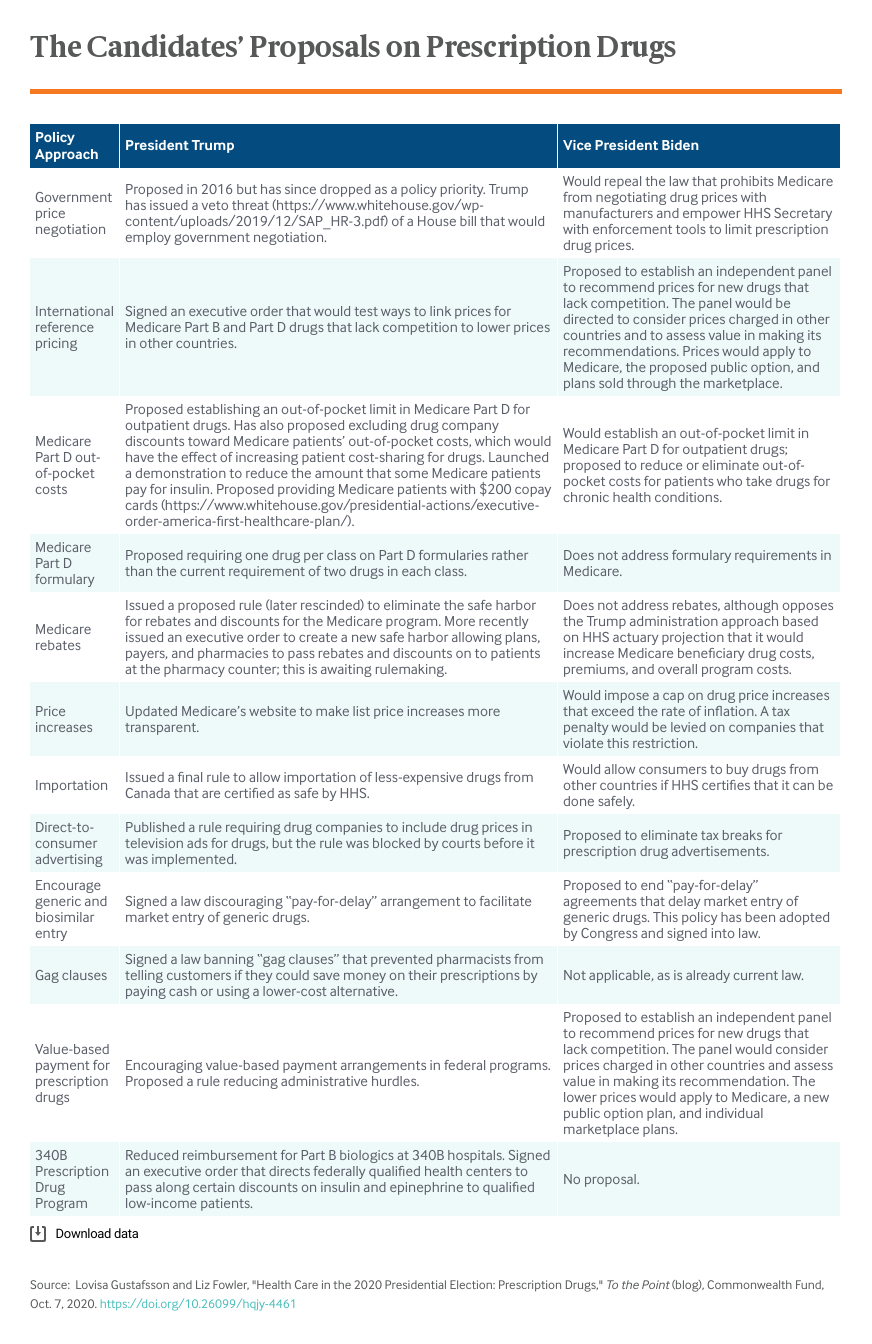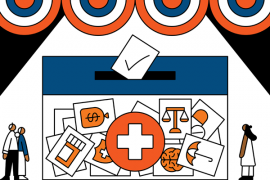The Issue
Patients are paying more for their prescription drugs when they go to the pharmacy, and Americans are paying higher prices for drugs than patients in other countries. As a result, they are unable to afford their medications, propelling drug pricing as a top issue for voters in recent elections. Both candidates for president have identified addressing high drug prices as a priority.
How President Trump and Vice President Biden Would Approach Prescription Drug Pricing
As a candidate in 2016, President Trump ran on prescription drug prices, stressing the need for government negotiation to align prices paid in the United States with lower prices paid in other countries. As president, he has proposed policies to address patient out-of-pocket costs and increase competition to lower drug prices, largely focusing on Medicare. Many of these efforts have been derailed, either because they were abandoned or blocked by courts, or because Congress has failed to enact drug-pricing legislation. The President has included drug-pricing proposals in his 2018 “American Patients First” blueprint and in his annual budgets; he also recently announced executive orders to address drug prices. However, he does not have a specific election platform on drug pricing.
Vice President Biden lays out his plan to reduce patient costs and address high drug prices in his campaign proposal and in recommendations by the campaign’s Unity Task Force. Biden’s proposals focus on reducing launch prices of new drugs, lowering prices of existing drugs, and alleviating patients’ out-of-pocket costs. These proposals extend beyond Medicare to include prices in a new public option and the marketplace.
There are several areas of similarity between the candidates’ proposals, such as decreasing seniors’ drug costs by capping out-of-pocket spending in Medicare Part D and importing drugs (i.e., those deemed safe by the U.S. Department of Health and Human Services) that cost less in other countries. Both candidates also have proposed international reference pricing — that is, tying U.S. prices to those paid in other countries. Lastly, they both promote competition by encouraging earlier market entry of generic drugs and biosimilars, a policy that was recently adopted by Congress.
However, despite many common elements, there are differences. President Trump’s proposals to address drug prices and affordability largely focus on Medicare patients; he has few policies that would directly impact prices paid by Medicaid, commercial, or uninsured patients. Alternatively, Vice President Biden has proposed to apply the policies to patients outside Medicare. Many of Trump’s proposals would make changes through administrative rulemaking, which does not require action by Congress, but some experts predict would be challenged in the courts. In contrast, most of Biden’s proposals require legislation, which is more difficult and less certain than regulation but less susceptible to legal challenges. And lastly, while President Trump ran on Medicare negotiation in the 2016 election to pool U.S. purchasing to lower drug prices, he has since abandoned that approach; Biden’s proposal includes it.

Implications of the Candidates’ Approaches
To assess the implications of the candidates’ approaches on prescription drug prices, the public might consider the following questions:
How do drug prices impact the cost of health care?
Drug prices have a direct impact on what Americans pay for their health care. First, as drug prices rise, so does your cost at the pharmacy counter if you have a deductible or pay coinsurance, are uninsured, or need a drug that isn’t covered by your insurance. Second, drug prices are factored into insurance premiums. When drug spending rises, premiums also may rise.
Will the approach of either candidate make prescription drugs more affordable?
Like many health care issues, drug-pricing policy is complicated and it is hard to estimate with any certainty the impact on out-of-pocket costs and premiums of each proposal. In some cases, a proposal may decrease prices at the pharmacy counter but increase premiums, making it difficult to assess the impact on an individual patient. Additionally, some proposals are targeted only at one payer (e.g., Medicare). This means that if you don’t have that coverage, the policy may not impact the price you pay. The ultimate effect of candidates’ drug-pricing plans will depend on the mix of policies that are adopted and implemented.
Will the approach impact innovation?
The drug industry has claimed that proposals made by President Trump and Vice President Biden will result in less investment in research and development, leading to fewer new drugs and less innovation over time. Proposals by both candidates would likely negatively impact industry profits, which would impact research and development investment, but some experts question the assertion that this effect alone would lead innovation to dry up. When scoring existing aggressive drug-pricing legislation, the Congressional Budget Office projected there would be a modest impact on innovation, with approximately 3 percent fewer new drugs coming to market over the next 10 years.
Is anything missing from the approach?
Neither candidate has addressed patent reform, though Vice President Biden hints at cracking down on efforts to manipulate the patent system in the Unity Task Force recommendations. Patents create a monopoly for drug makers, meaning they face no competition and can keep prices high and even increase them over time. Pharmaceutical and biotech companies have employed patent strategies to prolong exclusivity beyond intended or justified time frames that block generic and biosimilar competition. These periods of exclusivity are far longer in the United States than in other countries.




